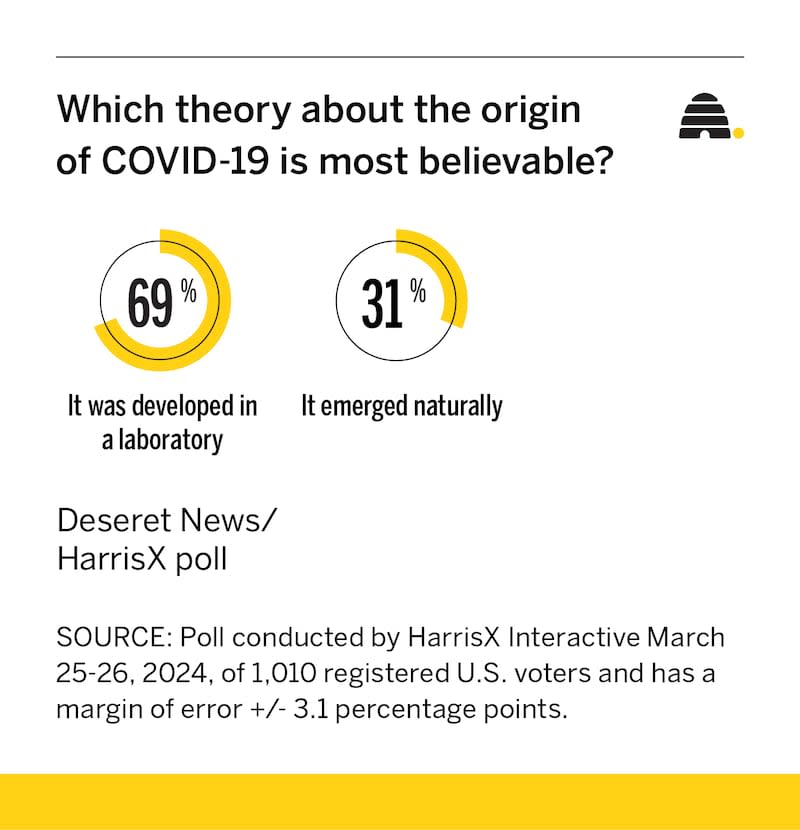7 out of 10 American voters think COVID-19 came from a lab

Four years after COVID-19 swept the globe, there is still no consensus on where it came from. Did the COVID-19 outbreak jump from animals to humans? Or did it unintentionally escape from a laboratory in Wuhan, China, that was studying similar viruses? Virologists and the intelligence community are split, at least in part because of a lack of information.
Congress has shown frustration over the ambiguity, as both the House and Senate have launched investigations into the virus’ origins — but it appears the American public has already made up its mind.
When asked what theory they support, 69% of American voters said SARS-CoV-2 came from a lab, while only 31% said it emerged naturally, according to the latest Deseret News/HarrisX poll.
“The lab leak theory is the most widely believed origin story for the pandemic among voters across the political spectrum and most demographics,” said Dritan Nesho, the CEO of HarrisX.
The survey was conducted among 1,010 registered U.S. voters on March 25-26. It has a margin of error of +/- 3.1 percentage points.

How the wet market theory went mainstream
The virus surfaced on a small scale in November 2019 in Wuhan, China. Initially, many scientists pointed to the open-air wet markets and said the coronavirus must have jumped from animals to humans. In February, the Chinese government temporarily closed these markets, where vendors sell live wild animals, like bats, badgers, wolf pups and bamboo rats.
By March 2020, a study published in Nature Medicine stated with certainty: “We do not believe that any type of laboratory-based scenario is plausible.” Their rationale wasn’t far-fetched. The two previous coronavirus outbreaks — severe acute respiratory syndrome, or SARS, and Middle East respiratory syndrome — had zoonotic roots.
Dr. Anthony Fauci, former director of the National Institute of Allergy and Infectious Diseases, who led the U.S. pandemic response, said in April 2020 on “Fox & Friends,“ the pandemic was a “direct result” of “unsanitary shopping” in those areas.
He later cited the March study from “highly qualified evolutionary virologists” as evidence for genetic sequences in COVID-19 evolving from bats.
Meanwhile, others pointed to evidence suggesting COVID-19 escaped from a lab. The proximity of the Wuhan Institute of Virology to the initial outbreak, the lab’s ties to a U.S. virology research organization and allegations that the virus’ genome was genetically manipulated backed this hypothesis.
But in the early days of the pandemic, this narrative, albeit controversial, did not have traction, due in part to several scientists speaking out against it and insinuating it was a conspiracy theory.
That started to change in June 2021, when comedian Jon Stewart, in an appearance on “The Late Show with Stephen Colbert,” reignited the debate, while making headlines, saying, “‘There’s been an outbreak of chocolaty goodness near Hershey, Pa. What do you think happened?’ Like, ‘Oh I don’t know, maybe a steam shovel mated with a cocoa bean?’ Or it’s the ... chocolate factory! Maybe that’s it?”
Why was the lab leak theory seen as conspiratorial?
Richard H. Ebright, a molecular biologist at Rutgers University and a vocal proponent of the lab leak theory, said in an interview with the Deseret News he believes public officials in the National Institutes of Health and other researchers didn’t investigate the lab leak theory thoroughly because of a conflict of interest. Between 2014 and 2020, the Wuhan lab received $1.4 million from the NIH and U.S. Agency for International Development, according to the Government Accountability Office.
Ebright said the NIH, and the EcoHealth Alliance, which partnered with the laboratory in Wuhan, “knowingly and willfully (imposed) a two-part false narrative that shows natural spillover, (and) that was the consensus of scientists.”
At a congressional hearing in August 2022, Ebright gave testimony that he believes the Wuhan lab was engaged in “gain-of-function” research, and was quoted in a Wall Street Journal piece in February of this year making an even stronger case that the virus came from the lab.
The congressional Select Subcommittee on the Coronavirus Pandemic held a hearing Tuesday to examine the relationship scientific journals had with the government when looking at the origins of COVID-19.
Holden Thorp, editor-in-chief of the Science Journals, was present but the heads of Nature and The Lancet declined to participate. “Science is a work-in-progress, and so, when we see new data, we change the way we’re thinking,” said Thorp.
Thorp cited a letter Science published in May 2021 that determined “theories of accidental release from a lab and zoonotic spillover both remain viable.” This letter, co-authored by 18 scientists, “ushered in a new era of consideration and debate,” he said in his testimony.
Thorp denied facing threats of censorship from the federal government for publishing competing opinions — nor did Fauci or any other official make any threats, he said.
U.S. intelligence community unsure of COVID-19 origins
The U.S. intelligence community has come to varied conclusions on the origins of the virus, suggesting both theories “remain plausible.”
Stephen Goldstein, a virologist and postdoctoral researcher at the University of Utah’s School of Medicine, told the Deseret News in a recent interview that although the FBI and the Energy Department agree COVID-19 likely came from a lab, they present different reasons for their conclusions and don’t display “a single coherent theory” backing their position.
Why scientists back the zoonotic origin theory
Goldstein said while both hypotheses are plausible, he doesn’t believe there is sufficient evidence that the virus escaped from the Wuhan lab. He has authored two studies, one of them peer-reviewed, that confidently signal a zoonotic source behind the virus.
Goldstein’s research traced the virus based on Chinese data points and found that SARS-CoV-2 materialized from the southwest quarter of the wet market selling live mammals. But he still doesn’t have all the answers about the virus turning up in the market and jumping from the animal to the intermediate host.
Scientists also haven’t found the species responsible for the virus. But Goldstein said that’s because “nobody’s looked.”
“If you walked right up to the animal that had it and you didn’t stick a swab in its nose, you’re not going to find it,” he added.

Goldstein agrees the lab accident theory was dismissed as a conspiracy at first. Facebook took down posts that claimed COVID-19 was man-made, which was on its list of misleading health claims, as did YouTube.
“I don’t think it was unreasonable to have questions like that early on. There’s a coronavirus lab there. Why wouldn’t people ask that question?” Goldstein said, but he is skeptical about the way the lab leak theory was advanced.
For Dr. Amesh Adalja of the Johns Hopkins Center for Health Security both hypotheses are plausible due to the circumstantial evidence and a lack of transparent investigation into the virus’ origins immediately following the outbreak.
Americans want more information on the origins of COVID-19
According to the Deseret News survey, half of Americans, or 49%, say they are satisfied with the government’s investigation into the virus, while 51% say they are unsatisfied.
But the responses differ along party lines. Only three out of 10 Republican voters were content with the inquiries into the virus’ origins, while 69% said they were unsatisfied. Among Democrats, seven out of 10 said they were satisfied, and 30% said they were dissatisfied with the federal government’s efforts. Among independent voters, a little over 40% were satisfied with the investigations and around 60% were unsatisfied.

Why do we need to study the origins of COVID-19?
Adalja said uncovering the true source of COVID-19 is valuable, whether to set better biosafety standards for labs working with viruses or to avoid animals that can play a role in transmission. After researchers discovered SARS-CoV-1 originated from Palm Civet cats, people “stopped dealing with them as a food source,” he said.
Congress continues to examine the origins of COVID-19.
In the Democratic-controlled Senate, the Homeland Security and Governmental Affairs Committee launched an investigation into the origin of COVID-19 last month. Six House committees, led by Republicans, have joined forces and have requested EcoHealth President Peter Daszak to testify before Congress in a public hearing on May 1 to “correct the record” related to questions about his organization’s research in Wuhan.
But it’s possible the question of where COVID-19 came from may remain a mystery.
“I don’t think there’s any way to know other than to get data regarding biosafety lapses that might have occurred at the Wuhan Institute of Virology — a full listing of viruses that they were using for experiments — as well a proper accounting of all the animals that were at the wet market,” Adalja said.

